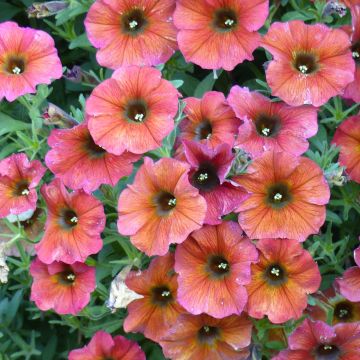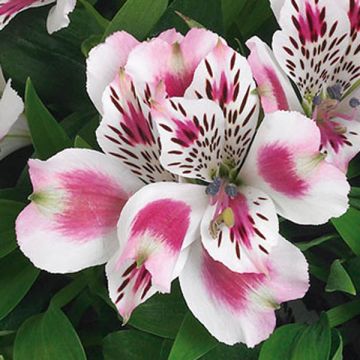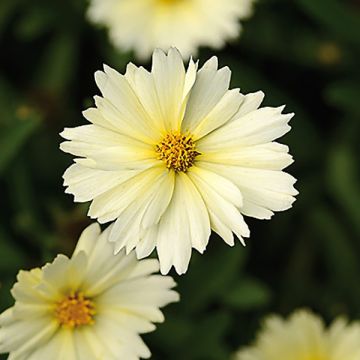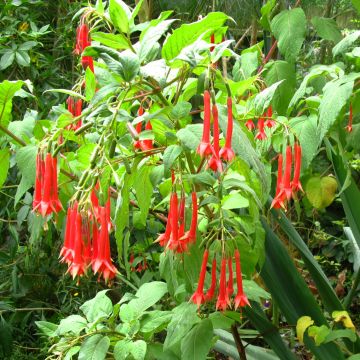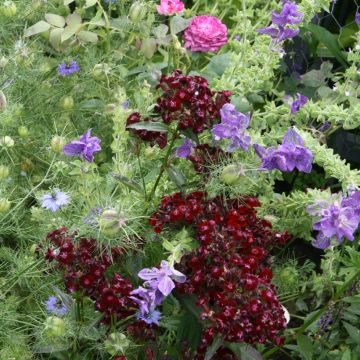

Portulaca oleracea Pazzaz Nano Yellow Twist
Portulaca oleracea Pazzaz Nano Yellow Twist
Portulaca oleracea Pazzaz Nano™ Yellow Twist™
Purslane, Little Hogweed
This item cannot be shipped to the selected country
Delivery charge from €5.90
More information
Schedule delivery date,
and select date in basket
This plant carries a 6 months recovery warranty
More information
We guarantee the quality of our plants for a full growing cycle, and will replace at our expense any plant that fails to recover under normal climatic and planting conditions.
From €5.90 for pickup delivery and €6.90 for home delivery
Express home delivery from €8.90.

Does this plant fit my garden?
Set up your Plantfit profile →
Description
The Portulaca Pazzaz Nano™ 'Yellow Twist' is an annual Purslane that is very interesting for its qualities of heat and drought resistance. It is a compact plant with a spreading and semi-trailing habit, with succulent foliage. It brings its bright and vibrant colour to summer compositions and is very floriferous. From spring to summer, its foliage is covered with large bright yellow flowers, with a bright orange center, which stay open for a longer time than other varieties. Plant it in the sun, in well-drained soil, even poor soil. Perfect as ground cover in rock gardens, but also in small hanging baskets and containers.
The Portulaca Pazzaz Nano™ 'Yellow Twist' belongs to the Portulaca family. Its ancestor, the common Purslane, is an annual herbaceous plant that is very common in gardens, especially in hot places and in degraded or compacted soil, particularly dry in summer. It is mainly found in the south of France and throughout the Mediterranean basin. The varieties of the Pazzaz Nano series have been selected for their increased floriferousness, larger and more colourful flowers that stay open from morning until evening, as well as their particularly compact habit.
The Portulaca Pazzaz Nano™ 'Yellow Twist' quickly forms a prostrate clump of creeping and branching stems that do not exceed 20 cm (8in) in height and spread up to 40 cm (16in). The green stems bear small elongated, lanceolate and fleshy leaves, with a bright green colour, sometimes bordered with copper tones. The flowering continues from late spring to September. The 3-4 cm (1-2in) diameter flowers are composed of crinkled iridescent petals like silk. Their color is a pure and vibrant yellow. A sunny exposure is required for them to fully open.
Plant 'Yellow Twist' Purslane in rock gardens and borders. On the terrace or balcony, plant it in hanging baskets or containers. Whether alone or in combination with other annual flowers, in small groups or planted en masse, it brightens up all sunny corners, in any well-drained garden soil. It forms a good ground cover in the company of drought-tolerant plants, such as silver-leaved wormwoods, thymes, succulent-leaved sedums, California poppies, or Delosperma.
Note: Please note that our young plug plants are professional products intended for experienced gardeners: upon receipt, transplant and store them in shelters (veranda, greenhouse, frame) at a temperature above 14°C (57.2°F) for a few weeks before being installed outdoors once the risk of frost has definitively passed.
Report an error about the product description
Flowering
Foliage
Plant habit
Botanical data
Portulaca
oleracea
Pazzaz Nano™ Yellow Twist™
Portulacaceae (Montiaceae)
Purslane, Little Hogweed
Cultivar or hybrid
Other Annuals A to Z
Planting and care
Install the young plants of annual purslane in pots in April or in open ground in May. Respect a spacing of 25 cm (10in) between the plants. Choose a very sunny location, in a warm exposure, in a light soil, even sandy, well-watered and cleared of weeds. Regular watering and fertilization during the season are necessary when plants are grown in pots, containers, hanging baskets, and planters.
Planting period
Intended location
Care
This item has not been reviewed yet - be the first to leave a review about it.
Plug plants - Annuals
Haven't found what you were looking for?
Hardiness is the lowest winter temperature a plant can endure without suffering serious damage or even dying. However, hardiness is affected by location (a sheltered area, such as a patio), protection (winter cover) and soil type (hardiness is improved by well-drained soil).

Photo Sharing Terms & Conditions
In order to encourage gardeners to interact and share their experiences, Promesse de fleurs offers various media enabling content to be uploaded onto its Site - in particular via the ‘Photo sharing’ module.
The User agrees to refrain from:
- Posting any content that is illegal, prejudicial, insulting, racist, inciteful to hatred, revisionist, contrary to public decency, that infringes on privacy or on the privacy rights of third parties, in particular the publicity rights of persons and goods, intellectual property rights, or the right to privacy.
- Submitting content on behalf of a third party;
- Impersonate the identity of a third party and/or publish any personal information about a third party;
In general, the User undertakes to refrain from any unethical behaviour.
All Content (in particular text, comments, files, images, photos, videos, creative works, etc.), which may be subject to property or intellectual property rights, image or other private rights, shall remain the property of the User, subject to the limited rights granted by the terms of the licence granted by Promesse de fleurs as stated below. Users are at liberty to publish or not to publish such Content on the Site, notably via the ‘Photo Sharing’ facility, and accept that this Content shall be made public and freely accessible, notably on the Internet.
Users further acknowledge, undertake to have ,and guarantee that they hold all necessary rights and permissions to publish such material on the Site, in particular with regard to the legislation in force pertaining to any privacy, property, intellectual property, image, or contractual rights, or rights of any other nature. By publishing such Content on the Site, Users acknowledge accepting full liability as publishers of the Content within the meaning of the law, and grant Promesse de fleurs, free of charge, an inclusive, worldwide licence for the said Content for the entire duration of its publication, including all reproduction, representation, up/downloading, displaying, performing, transmission, and storage rights.
Users also grant permission for their name to be linked to the Content and accept that this link may not always be made available.
By engaging in posting material, Users consent to their Content becoming automatically accessible on the Internet, in particular on other sites and/or blogs and/or web pages of the Promesse de fleurs site, including in particular social pages and the Promesse de fleurs catalogue.
Users may secure the removal of entrusted content free of charge by issuing a simple request via our contact form.
The flowering period indicated on our website applies to countries and regions located in USDA zone 8 (France, the United Kingdom, Ireland, the Netherlands, etc.)
It will vary according to where you live:
- In zones 9 to 10 (Italy, Spain, Greece, etc.), flowering will occur about 2 to 4 weeks earlier.
- In zones 6 to 7 (Germany, Poland, Slovenia, and lower mountainous regions), flowering will be delayed by 2 to 3 weeks.
- In zone 5 (Central Europe, Scandinavia), blooming will be delayed by 3 to 5 weeks.
In temperate climates, pruning of spring-flowering shrubs (forsythia, spireas, etc.) should be done just after flowering.
Pruning of summer-flowering shrubs (Indian Lilac, Perovskia, etc.) can be done in winter or spring.
In cold regions as well as with frost-sensitive plants, avoid pruning too early when severe frosts may still occur.
The planting period indicated on our website applies to countries and regions located in USDA zone 8 (France, United Kingdom, Ireland, Netherlands).
It will vary according to where you live:
- In Mediterranean zones (Marseille, Madrid, Milan, etc.), autumn and winter are the best planting periods.
- In continental zones (Strasbourg, Munich, Vienna, etc.), delay planting by 2 to 3 weeks in spring and bring it forward by 2 to 4 weeks in autumn.
- In mountainous regions (the Alps, Pyrenees, Carpathians, etc.), it is best to plant in late spring (May-June) or late summer (August-September).
The harvesting period indicated on our website applies to countries and regions in USDA zone 8 (France, England, Ireland, the Netherlands).
In colder areas (Scandinavia, Poland, Austria...) fruit and vegetable harvests are likely to be delayed by 3-4 weeks.
In warmer areas (Italy, Spain, Greece, etc.), harvesting will probably take place earlier, depending on weather conditions.
The sowing periods indicated on our website apply to countries and regions within USDA Zone 8 (France, UK, Ireland, Netherlands).
In colder areas (Scandinavia, Poland, Austria...), delay any outdoor sowing by 3-4 weeks, or sow under glass.
In warmer climes (Italy, Spain, Greece, etc.), bring outdoor sowing forward by a few weeks.


































